By the time October rolls around most people are no longer thinking about gardening. Sure, you can find an abundance of mums set out in pots for fall decoration, but our gardens are pretty much done for the year. Right? Not necessarily.
There are still quite a few native plant species that bloom at this time of year. And those late blooming native plants are crucial sources of pollen and nectar for pollinators. One of my favorite species that blooms in October, and often into early November, is Short’s aster (Symphyotrichum shortii).
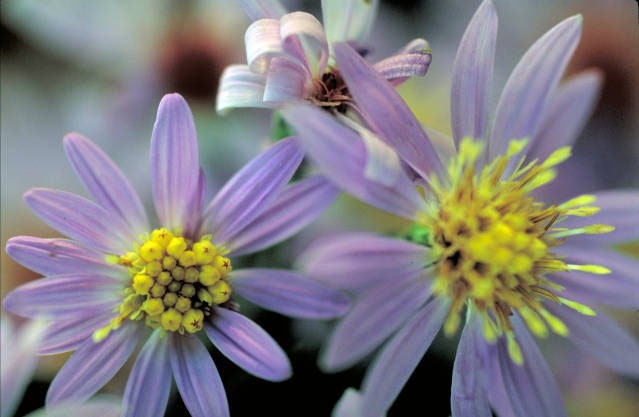
Native Range
According to BONAP, Short’s aster is native to Wisconsin, eastern Iowa, Illinois, Indiana, Ohio, western Pennsylvania, Kentucky, central Tennessee, Alabama, and small parts of some of the neighboring states.
What’s in a Name?
The “Short’s” in Short’s aster doesn’t refer to the plant’s size. Instead, the plant is named after Charles Wilkins Short who is called “the most widely acclaimed botanist west of the Alleghenies during the mid-1800s” in the book Plant Life of Kentucky: An Illustrated Guide to the Vascular Flora*. ( * affiliate link – We receive a small commission for purchases made through these links, but it comes at no extra cost to you. All commissions that we receive through affiliate links goes toward producing Backyard Ecology™ content. We appreciate your support.)
Short was a medical doctor and professor who lived in Kentucky and had a profound love of botany. During his lifetime Short is credited with discovering multiple new species of plants, creating an extensive collection of herbarium specimens which is still preserved at Philadelphia’ Academy of Natural Science, and writing or co-authoring multiple books on the plants of Kentucky.
How to Identify Short’s Aster
Short’s aster has simple, unlobed leaves that are arranged in an alternate pattern along the stem. The leaves have what’s called “entire margins” which simply means that the edges are smooth and look more like the edge of a butter knife than the serrated edge of a steak knife. The lower leaves are larger than the upper leaves. The lower leaves also have a wide base, pointy tip, and a distinct petiole or “leaf steam.”

The flowers of Short’s aster can be a very pale blue that looks almost white to a rich sky blue or lavender. The centers start out as yellow but then transition to a deep purple color. The whole plant tends to be around 2.5 to 3 feet tall. When the plant is in full bloom, the abundant flowers often cause the plant to lean forward.

Biology and Life History
Like all asters, Short’s aster is in the Asteraceae family along with black-eyed Susan, purple coneflowers, and many others. Like with all species in this family, what we think of as an individual flower is actually a composite of many smaller flowers. However, unlike black-eyed Susans, both the ray flowers (petals) and the disk flowers (centers) of Short’s asters are fertile and can produce seeds.
Short’s asters can bloom for almost a month or even a little longer. Here in Kentucky, I might start seeing a few blooms in late September, but the primary bloom happens in October. A few flowers will even last beyond the first killing frosts and still continue blooming into early November.
The long bloom time can create a profusion of blooms that can easily be spotted from a distance both by flower-loving humans and by flower-loving insects. The disk flowers on a Short’s aster’s flowerhead start out as a buttery yellow, then over a period of days or weeks turn a deep purple-ish color once it has been pollinated.
The disk flowers in many of our native asters change colors once they’ve been pollinated. While the ray flowers retain their color over a long period of time and help to form the equivalent of a neon sign that shouts, “Hey! Over here!” to any passing pollinator, the color of the disk flowers serves as a close-up signal that indicates to pollinators which specific flowers are still producing nectar.
In the wild, Short’s asters are typically found growing in dry, semi-shady areas that are often rocky, especially when the rocks are limestone. This can look like an open woodland or barren, a rocky roadcut, limestone bluffs, and similar locations.
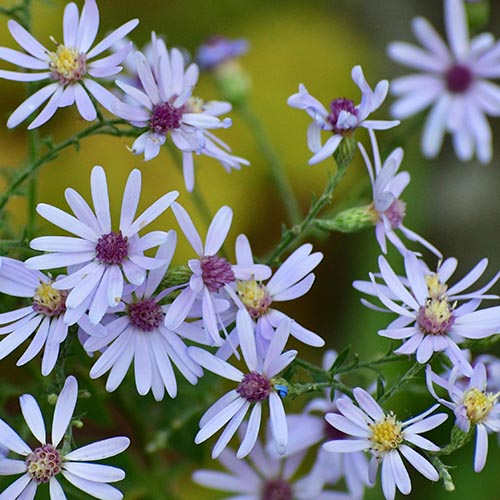
Pollinator and Wildlife Uses
The flowers of Short’s aster are highly attractive to a wide variety of native bees, skippers, and butterflies. There are multiple species of native bees that are pollen specialists for our native asters including Short’s aster. It is also a host plant for the caterpillars of the silvery checkerspot and the pearl crescent butterflies, as well as for the caterpillars of multiple species of moths. The seeds are eaten by a variety of birds and the foliage is sometimes eaten by deer, groundhogs, and rabbits.
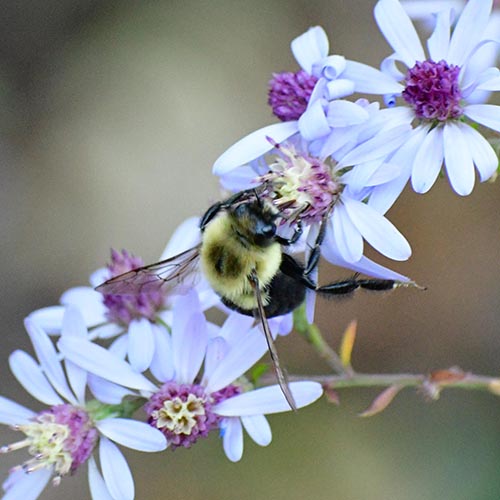
Incorporating Short’s Asters into Your Landscape
Short’s aster can be a great addition to a semi-shady area of your garden. If your soil is dry and kind of rocky, even better! It can take quite a bit of shade, but it does need some light. So don’t plant it in the deepest, darkest corner of your garden where nothing seems to grow but maybe a little moss and you feel like you need a flashlight to see what’s back there.
When you’re planting it, remember that it tends to lean over when it is in full bloom. So, don’t plant it right along the edge of a garden bed if you know that it’ll drive you (or others around you) nuts if the flowers are leaning out into the sidewalk or yard.
Also, be aware that Short’s aster can spread quite a bit by seed if it likes where it is at. This can be great if you want to fill in an area. (Yay! Free plants!) But it can also be frustrating if it starts spreading into areas where you don’t want it. The good news is that it’s easy to dig up, pull up, or simply mow down if you end up with more than you want.

Summary
Extending your growing season and having native plants that bloom in the mid to late fall is important for our late season pollinators, including next year’s queen bumble bees. One of the best ways to do that is to incorporate some of our late-blooming native fall asters into your landscape. And one of my favorite late-season fall asters for those semi-shady, dry, somewhat rocky (or really rocky) areas is Short’s aster (Symphyotrichum shortii).
If you would like personalized help creating your own pollinator and wildlife habitat, then we encourage you to check out the Backyard Ecology™ Community.
There’s lots of great “big picture” information available about creating pollinator gardens or larger habitats for pollinators and wildlife. What’s lacking are opportunities to say, “This is what I want to do. This is what I’m struggling with. How do I make it work on my property?”
That’s part of what the Backyard Ecology™ Community offers its members every day.
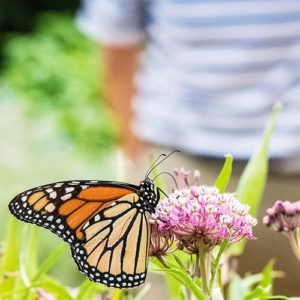
Thank you!
These amazing individuals go above and beyond every month to provide financial support which helps us create so much free content for everyone to enjoy and learn from.
Julie Krygier, Lizabeth, Russel Furnari, Crystal Robinson, Karen Veleta, Kevin B, Sally Mirick, Crystal Dyamonds, Mitchell Bell, Laura Hunt, Sue Ann Barnes, Adrienne Richardson, J. Adam Perkey, Ariel, Cara Flinn, David Todd, LaVonne Fitts, Cathy, Michael, Tom Winner, Eric Fleming, Julie, SB H, Christopher Scully, Craig, Rachel Antonucci, Melissa Egbertson, Switzy, CotswoldsCottageMA, Vilma Fabre, Pia O Nomata, Linda McNees, HerculesBiggerCousin, Patrick Dwyer, Paul Gourley, Lilith Jones, John Master, William Morin, Lori Sadie Ann, Debra, Ayn Zitzman, Han Mad, Isaac Kowis, Cathy Anderson, Betsy Lessels, Reid, and Dave Teare.
Backyard Ecology™: Creating thriving backyard ecosystems that you can enjoy and be proud of
We created Backyard Ecology™ to help you confidently create pollinator and wildlife habitat that you can enjoy and be proud of. Because nature isn’t just “out there.” It’s all around us, including right outside our doors.
Our focus on the eastern U.S. means that the information we share is applicable to you and where you live. Join us as we ignite our curiosity and natural wonder, explore our yards and communities, and improve our local pollinator and wildlife habitat.

Backyard Ecology™’s Guiding Principles:
🦋 Curiosity: Nature is fun, interesting, and worth exploring. We will never know everything. Answers lead to more questions. That’s half the fun.
🦋 Balanced: You don’t have to choose. You can support nature AND have a beautiful property that you can enjoy and be proud of.
🦋 Science informed: Habitat creation and management should be based on the latest scientific research available. This is true regardless of whether you’re working in a small garden or on hundreds of acres.
🦋 Stewardship: Anyone can make a positive difference in the natural world and leave an ecological legacy on their property.
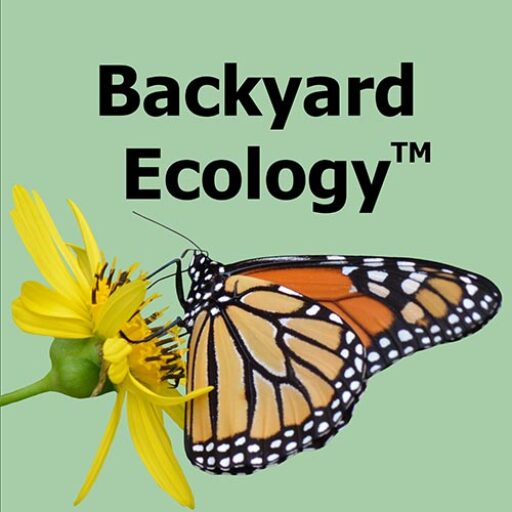
Leave a Reply